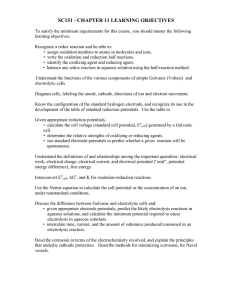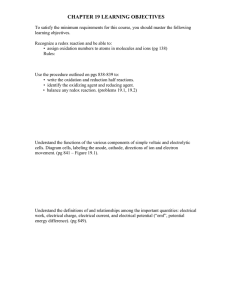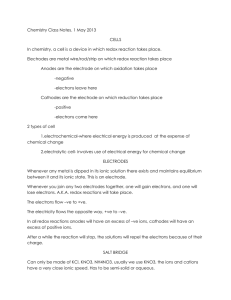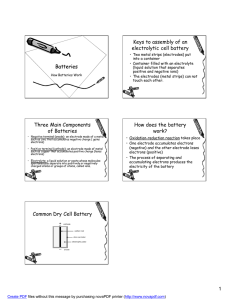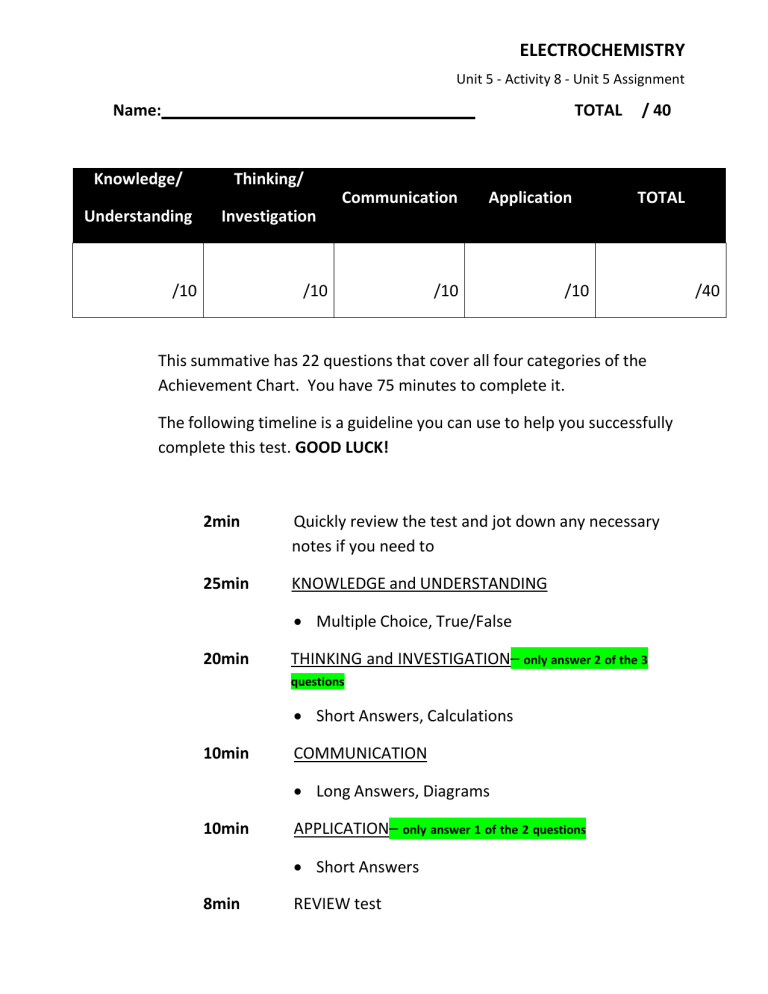
ELECTROCHEMISTRY Unit 5 - Activity 8 - Unit 5 Assignment Name: TOTAL Knowledge/ Thinking/ Communication Understanding / 40 Application TOTAL Investigation /10 /10 /10 /10 This summative has 22 questions that cover all four categories of the Achievement Chart. You have 75 minutes to complete it. The following timeline is a guideline you can use to help you successfully complete this test. GOOD LUCK! 2min Quickly review the test and jot down any necessary notes if you need to 25min KNOWLEDGE and UNDERSTANDING Multiple Choice, True/False 20min THINKING and INVESTIGATION– only answer 2 of the 3 questions Short Answers, Calculations 10min COMMUNICATION Long Answers, Diagrams 10min APPLICATION– only answer 1 of the 2 questions Short Answers 8min REVIEW test /40 KNOWLEDGE and UNDERSTANDING 10 marks (15 / 1.5) All multiple-choice questions are 1 mark each 11 marks 1. A galvanic cell is a) a chemical system that produces an electric current through a spontaneous redox reaction. b) a chemical system that uses an electric current to drive a non-spontaneous redox reaction. c) a flow of electrons in a circuit (= electrochemistry) d) a chemical system is which a solute conducts a current in an aqueous solution ( = electrolyte) e) a chemical system in which a compound breaks down into elements or simpler compounds ( = decomposition reaction) 2. Rusting is a) b) c) d) e) A decomposition reaction A combustion reaction A redox reaction A neutralization reaction A double displacement reaction 3. Primary batteries contain... a) b) c) d) e) Rechargeable cells No cells Fuel cells Electrolytic cells Galvanic cells 4. In both a galvanic cell and an electrolytic cell, a) b) c) d) e) Reduction occurs at the cathode The cell potential is positive The overall reaction is spontaneous An external voltage is required Chemical energy is converted to electrical energy 5. What is the oxidation state of gold in Au(CN)4-? a) b) c) d) 3 -1 0 4 6. Which of the following reactions is NOT a redox reaction? a) Na + Cl --->NaCl b) H2O2 --> HO2 + H+ c) Ni2+ + Fe ---> Fe2+ + Ni d) NaOH + HCl --->NaCl + H2O 7. Which of the following terms best describes CH4 in the following reaction? a) b) c) d) oxidized oxidizing agent hydrolyzed reduced 8. Which half-reaction takes place at the anode? a) b) c) d) The one with the greater reduction potential The one that transfers the most number of electrons The reduction The oxidation 9. What is a faraday? a) b) c) d) A unit of current A unit of energy A unit of charge A mole of electrons 10. Which of the following is NOT produced during the electrolysis of water? a) b) c) d) Electricity Acid Hydrogen Oxygen 11. At which electrode is H2 in the electrolysis of water? a) b) c) d) The anode The electrode connected to the negative side of the battery The cathode Cannot be determined with the given information Indicate whether each statement is true or false in the following five (5) questions. Each question is worth 1 mark. 4 marks 12. Electrolytic cells are based on non-spontaneous reactions and have a positive cell potential difference. 13. Cathodes are always positive in redox reactions. 14. In a redox reaction the number of total number of electrons lost equals the number of electrons gained. 15. A strong oxidizing agent has a great capacity to lose electrons. K: /13 A: /15 T: /8 SCH4U Unit 5 Assignment Electrochemistry Time Allowed – 90 minutes C: /10 No aids allowed except for a scientific calculator and formula sheet SHOW ALL YOUR WORK W.A. NAME: DATE: Question 1 a) What terminology is used for this common chemical reaction? [1K] b) Write out the full chemical reaction that is occurring. [2K] c) Give an example of when or where this chemical reaction would occur. [2A] d) Give 2 reasons why this commonly happens to iron (Fe). [1C] e) What are two ways of preventing this chemical reaction from occurring? Give a brief explanation of how each method works to prevent this chemical reaction. [4A,2T] Question 2 [3K,2A] Following are two reduction half – reactions for the half-cells of a voltaic cell. Determine the overall cell reaction and the standard potential. Write the cell chemistry using cell notation with vertical lines separating components. I2 (s) + 2e- → 2 I-(aq); Fe2+(aq) + 2e- → Fe (s); E0= 0.5355 V E0= - 0.447 V Your Solution: Question 3 [3K,3A] In an electrolytic cell, how many grams of Cu could be plated out of a CuSO4 solution at a current of 5.00 A for 2.00 min? (F = 96500 C/mol). Show your work. Your Solution: Question 4 [4C] Draw a diagram of an electrolytic cell and galvanic cell and explain the difference between both. Be sure to include flow of electron, electrical potential Question 5 What is the function of the acid in the lead-acid storage battery used in cars? [2A] The net reaction when a lead acid battery is discharged is the following: PbO2+ Pb + 2 H2SO4 → 2 PbSO4 + 2 H20 ii) Lead is both oxidized and reduced in the net reaction. Write the redox equation for each reaction. Hint: There is only a gain of 2 electrons by the lead. [2K] iii) Write the reaction for the formation of lead sulphate. Your equation should show what happens to the Pb2+. [2K] iv) Why does leaving on the lights or radio for too long with the engine off make the car battery go dead? [2A] v) What should you do if you have a dead car battery and why? [3T] Question 6 Electrolysis can be used to remove unwanted hair from the skin. Positive electrode The hair is first coated with a layer of gel containing ions in solution. The positive electrode is connected to a patch to the skin. Negative electrode Power supply The negative electrode is connected to the hair. Electricity flows through the gel and causes electrolysis of the body fluid around the hair follicle. Hair Body fluid Hair follicle (a) (b) Metal wires conduct electricity to the electrodes. Explain how metals conduct electricity. [2C] Explain why the gel containing ions in solution can conduct electricity. [2C] (c) The body fluid is a solution that contains sodium chloride. The electricity causes the electrolysis of a small amount of this solution. This solution contains hydrogen ions that move to the negative electrode. (i) The half equation represents the reaction at the negative electrode. 2H+ + 2e– → H2 Explain why this reaction is a reduction. [1C] Complete the half equation for the reaction at the positive electrode. Cl– → Cl2 [3T]
